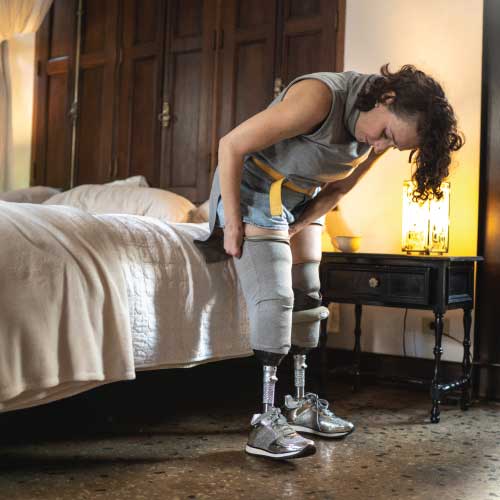Cutting-Edge Neuroprosthetic System Mimics Natural Limb Function
Reading Time: 4 minutes
Prosthetic technology has evolved remarkably, transitioning from basic mechanical devices to sophisticated bionic limbs that strive to mimic natural limb function. However, current bionic legs can still be improved. A study published in Nature Medicine in July 2024 explored the limitations of existing bionic limbs and what else can be done to improve them.

Using muscle afferent and efferent signals
According to the researchers, the disappointing state of existing bionic limbs is not surprising as human legs are complex.
The way people walk involves coordinated interaction between afferent and efferent signals. The former refers to messages sent from the leg muscles and other parts of the body to the brain, while the latter refers to messages that go the other way—from the brain to the leg muscles—to initiate an action.
However, the standard amputation surgery makes it difficult to use these signals to better operate neuroprosthetics. Standard amputation involves discarding substantial amounts of distal tissue, which leads to the loss of peripheral afferents that are responsible for mobility.
Augmenting muscle afferents with AMI
Understanding the role muscle afferents play in human gait, the researchers experimented with augmenting muscle afferents within the residual limb of individuals with below-knee limb loss. This would help the prosthetic user move smoothly and intuitively with a neuroprosthetic leg.
The researchers suggested a modified amputation procedure known as the agonist-antagonist myoneural interface (AMI) to enhance residual muscle afferents. This procedure involves surgically connecting agonist-antagonist muscles in the residual limb to replicate the natural dynamics of these muscle pairs.
Agonist-antagonist muscle dynamics involve the contracting (agonist) and relaxing or lengthening (antagonist) actions of muscle pairs. These dynamics play a crucial role in controlling limb movement. Without agonist-antagonist muscle pairs, manipulating objects or maintaining balance effectively would be challenging.
The study
This research is part of an ongoing clinical trial evaluating the effectiveness of the AMI procedure in enhancing neuroprosthetic control. The clinical trial has tested individuals with below-knee limb loss.
The AMI amputation surgery involves connecting muscle pairs in the residual limb to imitate how muscles normally work. The idea is to use the natural sensory organs in the remaining muscles and tendons to create artificial sensory signals that correspond to moving the joints.
The study involved seven participants aged 18-65, who were classified as K-levels 3 and 4. Additionally, seven participants who did not undergo the AMI amputation joined the study as the control group.
For prostheses, the researchers used a bionic limb equipped with a powered prosthetic ankle, an electromyography (EMG) sensor unit, and flexible surface electrodes.
Results
The study found that the AMI procedure led to a more natural gait under continuous neural control. Those who underwent the procedure also showed a 41% higher maximum walking speed than the control group.
Furthermore, the AMI subjects showed a natural ability to adapt to various terrains, such as slopes and stairs, in contrast to the control group. They were able to modulate shock absorption when descending stairs and propulsive torque during the pull-up phase of ascending stairs, which was not achievable with previous bionic limbs.
The researchers also assessed the neuroprosthetic's ability to navigate obstacles and environmental disruptions in real-world scenarios. They found that the AMI subjects responded to disruptions, including stepping over obstacles while walking, in a manner similar to people with biologically intact limbs.
The bottom line
The research findings show that by enhancing muscle-tendon signals in the residual limb, individuals with below-knee limb loss can directly control biomimetic movement using neuroprosthetics. This allows for adjustments in walking speed, navigation of different terrains, and overcoming obstacles.
While these capabilities surpass those of current bionic legs, the researchers highlighted that there is a need for further research. We need to know the long-term effects of using neuroprosthetics driven solely by the human nervous system through augmented muscle signals in the residual limb.











































































